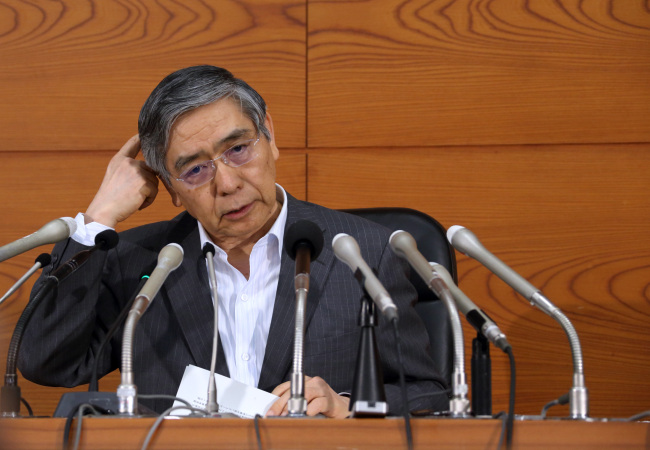DEAD SEA, Jordan (Reuters) ― Bank of Japan Gov. Haruhiko Kuroda said on Saturday a massive stimulus policy introduced a year ago had achieved its goal of boosting the real economy, lifting growth and ending deflation but said a 2 percent inflation of two years could take more time to achieve.
He said that the its ultra-easy monetary QQE (quantitative and qualitative easing) policy introduced last April when the BOJ pledged to double base money via aggressive asset purchases to accelerate consumer inflation to 2 percent in roughly two years had attained its goals.
“One year has passed ... the policy has been having the intended effects leading to an improvement in financial markets, the real economy, prices,” Kuroda told an audience attending the 17th world congress of the International Economic Association held in Jordan.
On whether it was possible meet the two-year inflation target, one year into the stimulus plan, Kuroda hinted it could take longer.
 |
Bank of Japan Gov. Haruhiko Kuroda. (Bloomberg) |
“When the BOJ introduced QQE we declared we would intend to achieve a 2 percent inflation target basically within two years time,” Kuroda said.
“The policy of QQE will be maintained and will be continued until we achieve the 2 percent inflation target and also maintain a 2 percent inflation in a sustainable manner so it may take more than two years if necessary and anyway we are only half way,” Kuroda said
The BOJ governor said the “large-scale monetary easing” had led to peoples’ inflation expectations rising on the whole.”
Excluding the effect of the tax hike, inflation accelerated to 1.5 percent in April compared with year-on-year a negative 0.5 percent excluding fresh food in March last year, Kuroda said.
Kuroda said the “bank’s massive purchases of JGB have kept 10-year government bonds yields at a low level of about 0.6 percent.”
Exiting QQE could carry risks and was premature now, he added.
The BOJ under the QQE will continue purchasing long-term government bonds “with average maturities of six to seven years” until the 2 percent inflation target was met,” Kuroda said.
“So discussing exiting strategy, how to exit and when to exit is certainly too premature although I can say there are many options and ways to gradually exit from QQE in coming months,” he added.
Kuroda said the Japan’s economic growth was led by domestic demand, with the policy of BOJ “to encourage a decline in real interest rates through raising inflation expectations and thereby stimulate the real economy.”
“As a result real interest rates have been negative and continue to decline, thereby providing stimulus to the real economy”.
“Radically changing inflation expectations among the private households” would revive private demand, particularly investments as well as consumption that had experienced sharp downturns after the Lehman crisis,” Kuroda said.
Although the government could achieve its objective of eliminating Japan’s primary deficit by 2020, rising overall debt posed a long-term problem for policy makers, Kuroda.
“So we don’t see excessive private sector debt accumulating overhang or whatever, the problem is only the government which continues to have large debt GDP now is more than 200 percent and the government has belatedly started to reduce fiscal deficit,” Kuroda said.
“Even if the government objective of eliminating the primary deficit by 2020, even if that is achieved, debt will continue to rise and that could be a serious problem for the government as well as the economy,” he warned.








